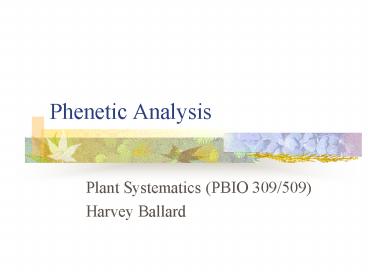Phenetic Analysis
1 / 18
Title: Phenetic Analysis
1
Phenetic Analysis
- Plant Systematics (PBIO 309/509)
- Harvey Ballard
2
Principles of Phenetic (Distance) Analysis
- Use overall similarity among taxa (populations,
species, etc.)all characters boiled down a
matrix of pairwise similarities - Collapse multidimensional patterns of variation
into very few artificial dimensions, to permit
interpretation
3
Principles of Phenetic (Distance) Methods
- Sometimes the only valid approach for some kinds
of datae.g., continuous morphological variables,
population-level molecular markers - Very successful for distinguishing recognizable
taxa in a group of closely related plants
(especially below genus level)
4
Principles of Phenetic (Distance) Methods
- Sometimes the only valid approach for some kinds
of datae.g., continuous morphological variables,
population-level molecular markers - Very successful for distinguishing recognizable
taxa in a group of closely related plants
(especially below genus level)
5
Characters
- Variables ideally continuous (permits greatest
flexibility of analysis) can include binary,
multistate qualitative traits but this severely
limits analytical methods - Very useful to do initial (even preliminary)
group assignments for samples
6
Analytical Approaches
- Four main types
- Cluster analysisuses similarity matrix
- Principal components analysisuses original data
set - Principal coordinates analysisuses dissimilarity
matrix from Gowers coefficient (allows mixed
data types) - Canonical variates analysisuses original data
set - CVA alone requires samples assigned to groups,
but most powerful of all methods
7
ExampleMesoamerican Hybanthus elatus complex
What the Hell are these!?
8
ExampleMesoamerican Hybanthus elatus complex
potosinus
verbenaceus
el X verb??
elatus
9
ExampleMesoamerican Hybanthus elatus complex
Leaf shape, margin and petiole traits
10
ExampleMesoamerican Hybanthus elatus complex
11
ExampleMesoamerican Hybanthus elatus complex
12
ExampleMesoamerican Hybanthus elatus complex
- Pollen stainability data
elatus
??
poto
verb
13
ExampleMesoamerican Hybanthus elatus complex
- Weird Hybanthus largely distinct from relatives
but intermediate between H. elatus and H.
verbenaceus - Distributed between them geographically and
altitudinally, ecologically distinct from both - Pollen stainability?partially sterile
- Produces normal fruits and seeds!
- Recent hybrid derivative, now partly stabilized?
14
ExampleCentral and Marginal Populations of
Froelichia floridana
- Study began with ecological investigations of
Ohios only (endangered) population of Froelichia
floridana (Snake Cotton, Amaranthaceae) - McCauley needed genetic data to interpret
diversity and affinities to other source areas - Used Inter-Simple Sequence Repeat (ISSR)
fingerprinting method
15
ExampleCentral and Marginal Populations of
Froelichia floridana
Ohio pop
- Ohio population not known in early 1900s
- Found in 1954 along Ohio River near Marietta
- Currently state endangered
McCauley and Ballard (2002)
16
ExampleCentral and Marginal Populations of
Froelichia floridana
- Genetic data analyzed using Neighbor-joining
(related to Cluster Analysis) - All state samples coherent units
- Ohio groups w/Midwestern pops
McCauley and Ballard (2002)
17
ExampleCentral and Marginal Populations of
Froelichia floridana
- Analysis of Molecular Variance compared ISSR
diversity of central (old) vs. marginal
(recent) populations - Genetic diversity of central populations gtgt
marginal ones - ?Marginal pops (incl. OH) recent migrants
McCauley and Ballard (2002)
18
References































